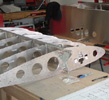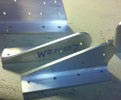


random user submitted photo
4' to 6" Tailwheel
6 posts
• Page 1 of 1
4' to 6" Tailwheel
Hi All,
My Sonex Legacy "lives" on a grass airfield field.
Rain soaked ground impacts differently on all the aircraft at the field. Some, with big tyres, hardly seem to be affected - Opps only being cancelled to reduce surface damage. Others, with more in proportion tyres, must wait for firmer ground before venturing forth.
My little tailwheel Sonex needs to have no soft patches at all, before I can easily taxi/TO/Land
The 4" API tailwheel cuts a furrow, on all but the hardest (dry) ground, making taxying a challenge and doing damage to the airfield surface.
I am considering changing to a 6" wheel, in the hope that it would provide better "flotation" & less rolling resistance, enabling me to get back into the air much sooner, after rain.
I hope the Forum Brains Trust will debate the pros/cons of making the above change.
My Sonex Legacy "lives" on a grass airfield field.
Rain soaked ground impacts differently on all the aircraft at the field. Some, with big tyres, hardly seem to be affected - Opps only being cancelled to reduce surface damage. Others, with more in proportion tyres, must wait for firmer ground before venturing forth.
My little tailwheel Sonex needs to have no soft patches at all, before I can easily taxi/TO/Land
The 4" API tailwheel cuts a furrow, on all but the hardest (dry) ground, making taxying a challenge and doing damage to the airfield surface.
I am considering changing to a 6" wheel, in the hope that it would provide better "flotation" & less rolling resistance, enabling me to get back into the air much sooner, after rain.
I hope the Forum Brains Trust will debate the pros/cons of making the above change.
- Skippydiesel
- Posts: 799
- Joined: Tue Jul 06, 2021 6:24 am
Re: 4' to 6" Tailwheel
I have the Peter Anson 6 inch tailwheel and fly off a grass strip with sandy soil. My tailwheel will dig a little furrow when the ground is moist. Inevitable with sandy soil. Works fine when dry. When I first started to taxi with the standard size tires on the mains and tailwheel it took considerable RPM to get around. I changed to larger tires on the mains and went 6 inch on the tailwheel. It takes less effort on the throttle now to taxi as I had hoped. The downside is more weight. I think the easier taxi is more a function of the larger tires on the mains than the tailwheel. I think you would have to go wider on the tailwheel, not taller to keep from digging in. My ultralight tailwheel has a narrow tailwheel as well. same effect. I call them my pizza cutter tailwheels when telling airplane stories.
Gregg Kaat
Sonex B #0014
Sonex B #0014
- T41pilot
- Posts: 142
- Joined: Sat Nov 26, 2016 3:57 pm
- Location: Howard City, Michigan
Re: 4' to 6" Tailwheel
Thanks T41,
Your, from life (not theory) comments are thought provoking.
From my early training, there are only three practical ways to increase the wheel "footprint":
# Increase the width - you have referred to this. This is often the direction that performance cars will go in, when space (wheel arches, etc) limits fitting a larger diameter wheel
# Increase the diameter - what you call taller. Larger diameter confers not just a larger footprint but also reduced rolling resistance. Rolling characteristics will affect the tendency of the wheel to damage/break through the ground surface.
# Lowering tyre pressure (only applicable to pneumatics). This allows the tyre to flex/distort, presenting a larger area (footprint) to the ground. Minimal application when talking tailwheels.
The above can be summarised as flotation - the ability of the wheel to remain on the ground surface, rather than cut through (make a furrow or bogging down)
Pneumatic V Solid Tyres:
Pneumatic -
# As a general rule, a correctly inflated tyre (Peter Anson tailwheels) will have a lower surface pressure (better flotation) than a solid one of the same diameter (API ). This is due to the ability of the pneumatic tyre to distort/flex and present a larger surface area to the ground than that of the solid. The pneumatic also has the advantage of tyre pressure adjustments (within a small range). Pneumatics likely are less noisy on sealed surfaces compared with solid tyres.
Solid -
# The advantage of the solid tyre is wear and puncture resistance. Speculation: A solid tyre may last longer than pneumatic. Puncture resistance is a significant factor, here in Australia, for aircraft operating on grass (runway/taxiway) due to thorns that can puncture tyres.
For aircraft there are other factors:
# Weight - may change the handling characteristics of the aircraft. The tailwheel being at one extreme of the aircraft dimension could have a significant effect.
# Drag - may reduce the aircraft's performance. Probably not significant for your average pilot - racing pilots may see this differently.
So back to my Sonex larger diameter tailwheel:
Weight Changes
# In cruise, my aircraft flies with some up elevator (down force). A heavier (larger?) tailwheel may reduce this tendency & drag, thereby marginally improve aerodynamic efficiency (speed/fuel). Peter Anson claims his tailwheels are actually lighter than solids. API 6" is only about 1 kg (2lb) slightly heavier than the 4"
Drag Changes
# A larger tail wheel, shape & surface area, may increase drag thereby marginally reducing aerodynamic efficiency (speed/fuel).
Cost Benefit
# Nill cost, do nothing - I will just have to put up with going flying a day or so later/less than my chums with fat tyres/nose wheels.
Spend the inheritance - Hmmm! To go to 6" would have to purchase the whole castering mechanism. About $600 from API (will fit) and $400 from PA (may need further modifications to fit).
Subject to further advice, the combination of your observations & my BS above - I think I will live with the 4" . At least until it wears out.
Your, from life (not theory) comments are thought provoking.
From my early training, there are only three practical ways to increase the wheel "footprint":
# Increase the width - you have referred to this. This is often the direction that performance cars will go in, when space (wheel arches, etc) limits fitting a larger diameter wheel
# Increase the diameter - what you call taller. Larger diameter confers not just a larger footprint but also reduced rolling resistance. Rolling characteristics will affect the tendency of the wheel to damage/break through the ground surface.
# Lowering tyre pressure (only applicable to pneumatics). This allows the tyre to flex/distort, presenting a larger area (footprint) to the ground. Minimal application when talking tailwheels.
The above can be summarised as flotation - the ability of the wheel to remain on the ground surface, rather than cut through (make a furrow or bogging down)
Pneumatic V Solid Tyres:
Pneumatic -
# As a general rule, a correctly inflated tyre (Peter Anson tailwheels) will have a lower surface pressure (better flotation) than a solid one of the same diameter (API ). This is due to the ability of the pneumatic tyre to distort/flex and present a larger surface area to the ground than that of the solid. The pneumatic also has the advantage of tyre pressure adjustments (within a small range). Pneumatics likely are less noisy on sealed surfaces compared with solid tyres.
Solid -
# The advantage of the solid tyre is wear and puncture resistance. Speculation: A solid tyre may last longer than pneumatic. Puncture resistance is a significant factor, here in Australia, for aircraft operating on grass (runway/taxiway) due to thorns that can puncture tyres.
For aircraft there are other factors:
# Weight - may change the handling characteristics of the aircraft. The tailwheel being at one extreme of the aircraft dimension could have a significant effect.
# Drag - may reduce the aircraft's performance. Probably not significant for your average pilot - racing pilots may see this differently.
So back to my Sonex larger diameter tailwheel:
Weight Changes
# In cruise, my aircraft flies with some up elevator (down force). A heavier (larger?) tailwheel may reduce this tendency & drag, thereby marginally improve aerodynamic efficiency (speed/fuel). Peter Anson claims his tailwheels are actually lighter than solids. API 6" is only about 1 kg (2lb) slightly heavier than the 4"
Drag Changes
# A larger tail wheel, shape & surface area, may increase drag thereby marginally reducing aerodynamic efficiency (speed/fuel).
Cost Benefit
# Nill cost, do nothing - I will just have to put up with going flying a day or so later/less than my chums with fat tyres/nose wheels.
Spend the inheritance - Hmmm! To go to 6" would have to purchase the whole castering mechanism. About $600 from API (will fit) and $400 from PA (may need further modifications to fit).
Subject to further advice, the combination of your observations & my BS above - I think I will live with the 4" . At least until it wears out.
- Skippydiesel
- Posts: 799
- Joined: Tue Jul 06, 2021 6:24 am
Re: 4' to 6" Tailwheel
Spend the inheritance - Hmmm! To go to 6" would have to purchase the whole castering mechanism. About $600 from API (will fit) and $400 from PA (may need further modifications to fit).
Just a couple of corrections: The pneumatic tail wheels I supply cost A$340 (about US$220 on current exchange rates). That's for the complete assembly with caster and pivot fitting. If you have a standard Sonex tail spring they don't require any modification to fit.
The wheel and tire alone weighs 415 grams or 14.6 ounces which is lighter than the 4" solid wheel that I was able to check. The complete assembly of wheel, tire, caster and pivot fitting weighs 740 grams or 26 ounces.
I don't make any claims for mud performance but if you can measure any drop in performance from extra aerodynamic drag you've got better instrumentation than me. At one time I used an 8" x 2" tail wheel and even with that size wheel I couldn't notice any extra drag.
Peter
- peter anson
- Posts: 558
- Joined: Thu Jul 31, 2014 2:34 am
- Location: Mount Macedon, Australia
Re: 4' to 6" Tailwheel
Thanks for that Peter,
My costings were rounded up and allowed for delivery and any additional mods to the existing tail wheel installation.
Your comments on changes to performance (drag/weight) are enlightening.
Have you or any of your customers had issues with thorn punctures?
My costings were rounded up and allowed for delivery and any additional mods to the existing tail wheel installation.
Your comments on changes to performance (drag/weight) are enlightening.
Have you or any of your customers had issues with thorn punctures?
- Skippydiesel
- Posts: 799
- Joined: Tue Jul 06, 2021 6:24 am
Re: 4' to 6" Tailwheel
Hi Skippy, I have been using a pneumatic tail wheel for about 10 years and at least 650 landings. In that time I have had two flats. I forgot to check the pressure and didn't notice that it was low until a passenger climbed into the aircraft. I wasn't carrying a pump so trusted to luck which didn't hold. The other flat was a slow leak which appeared to be a fault in the inner tube. The tyres are very light and definitely wouldn't be immune to thorns but they have not been a problem anywhere I have flown.
Peter
Peter
- peter anson
- Posts: 558
- Joined: Thu Jul 31, 2014 2:34 am
- Location: Mount Macedon, Australia
6 posts
• Page 1 of 1
Who is online
Users browsing this forum: No registered users and 27 guests







